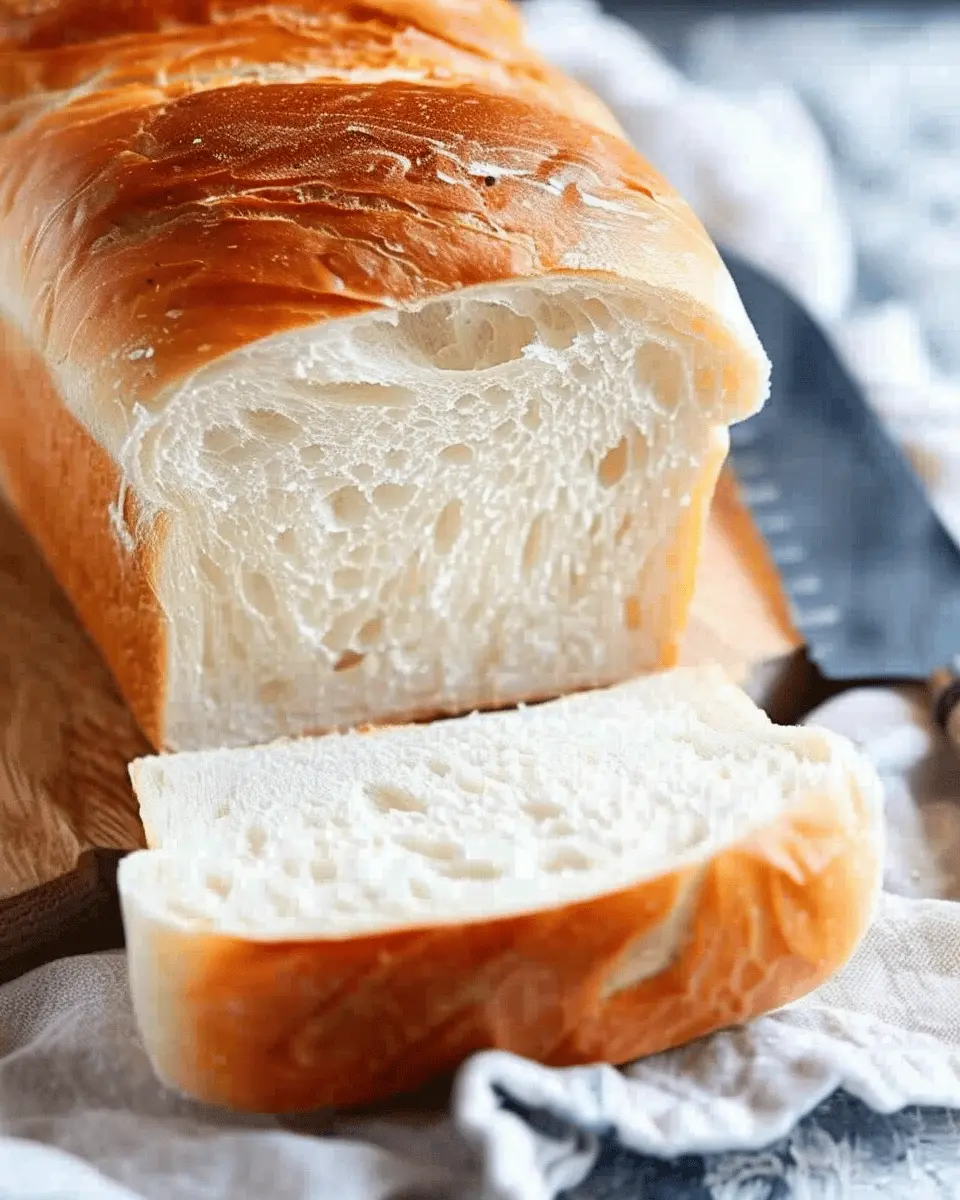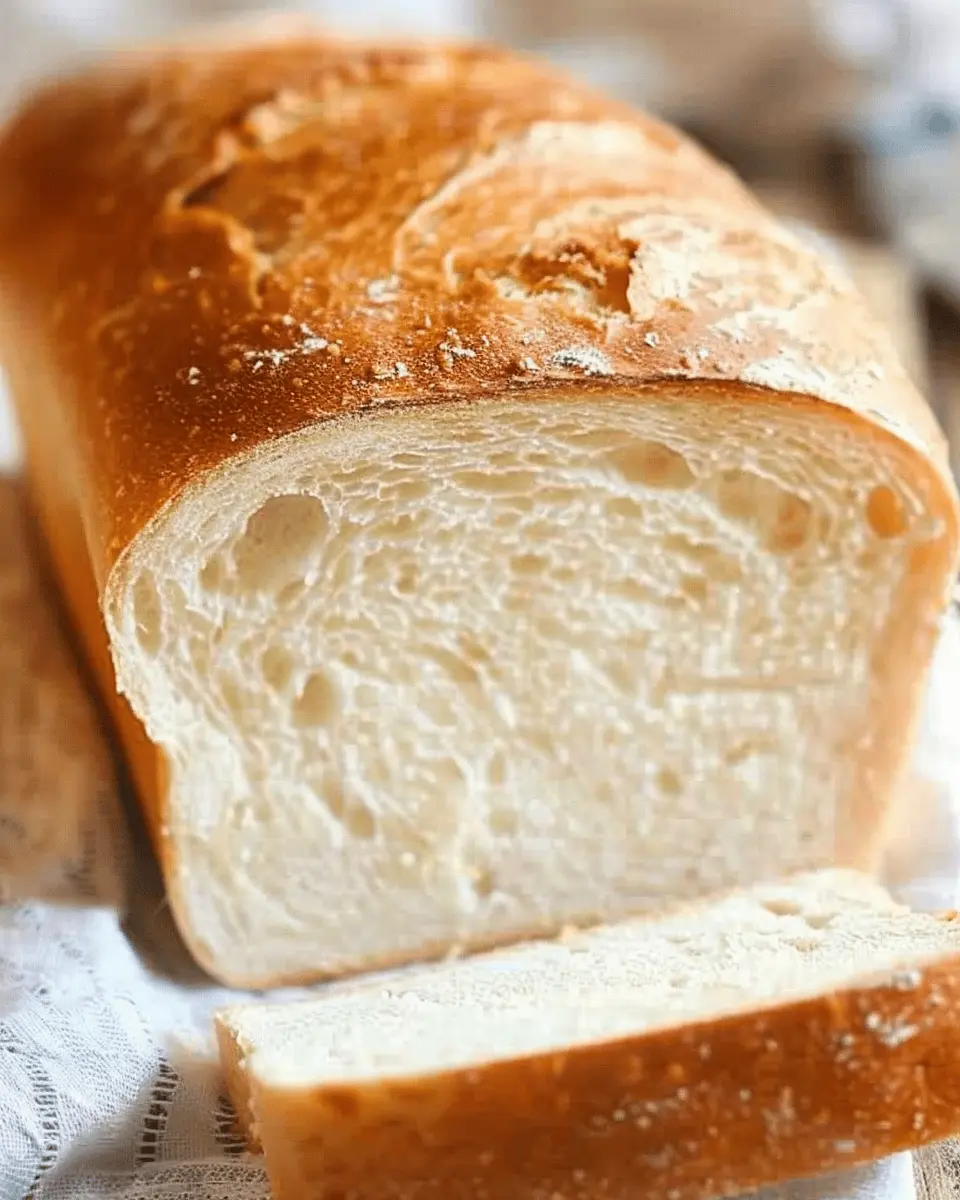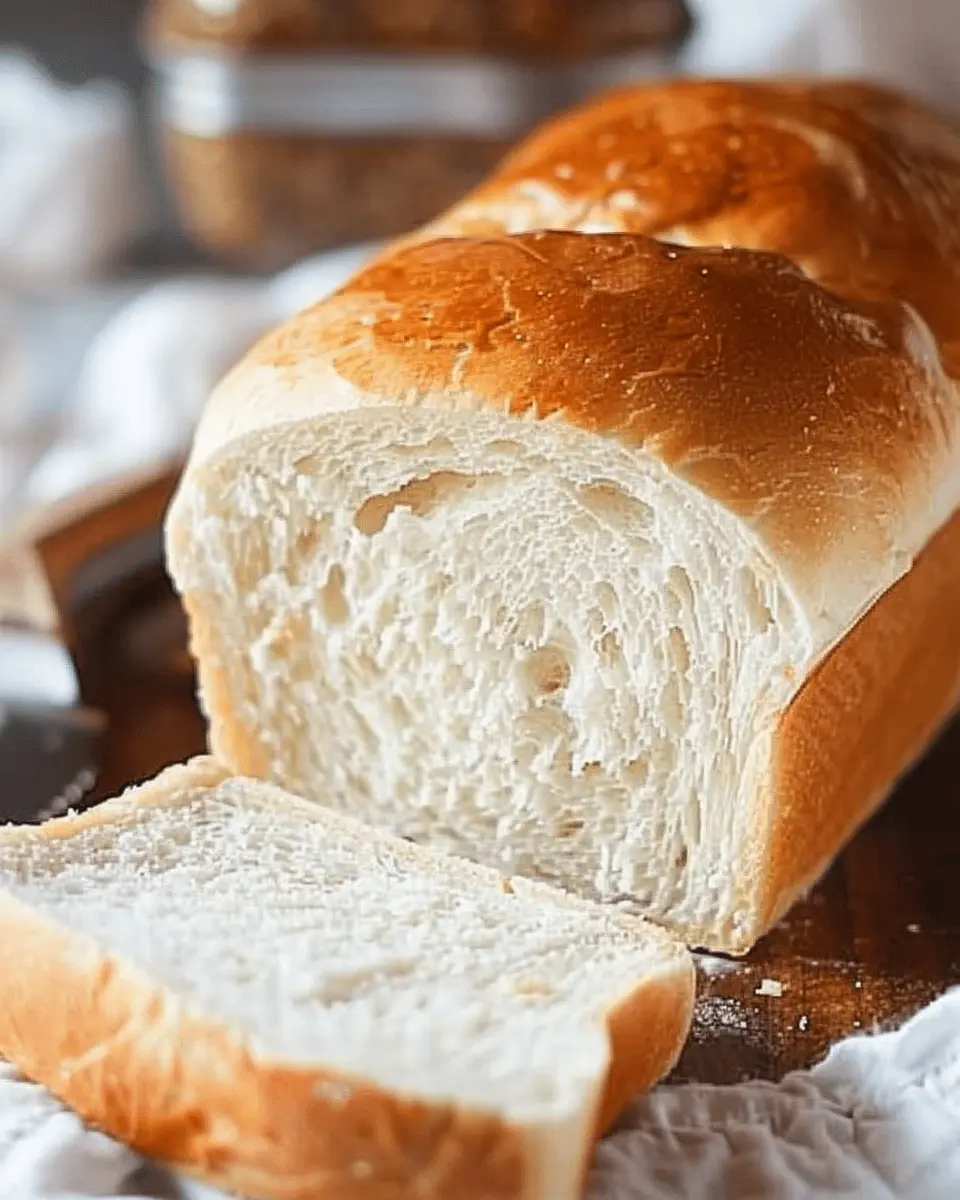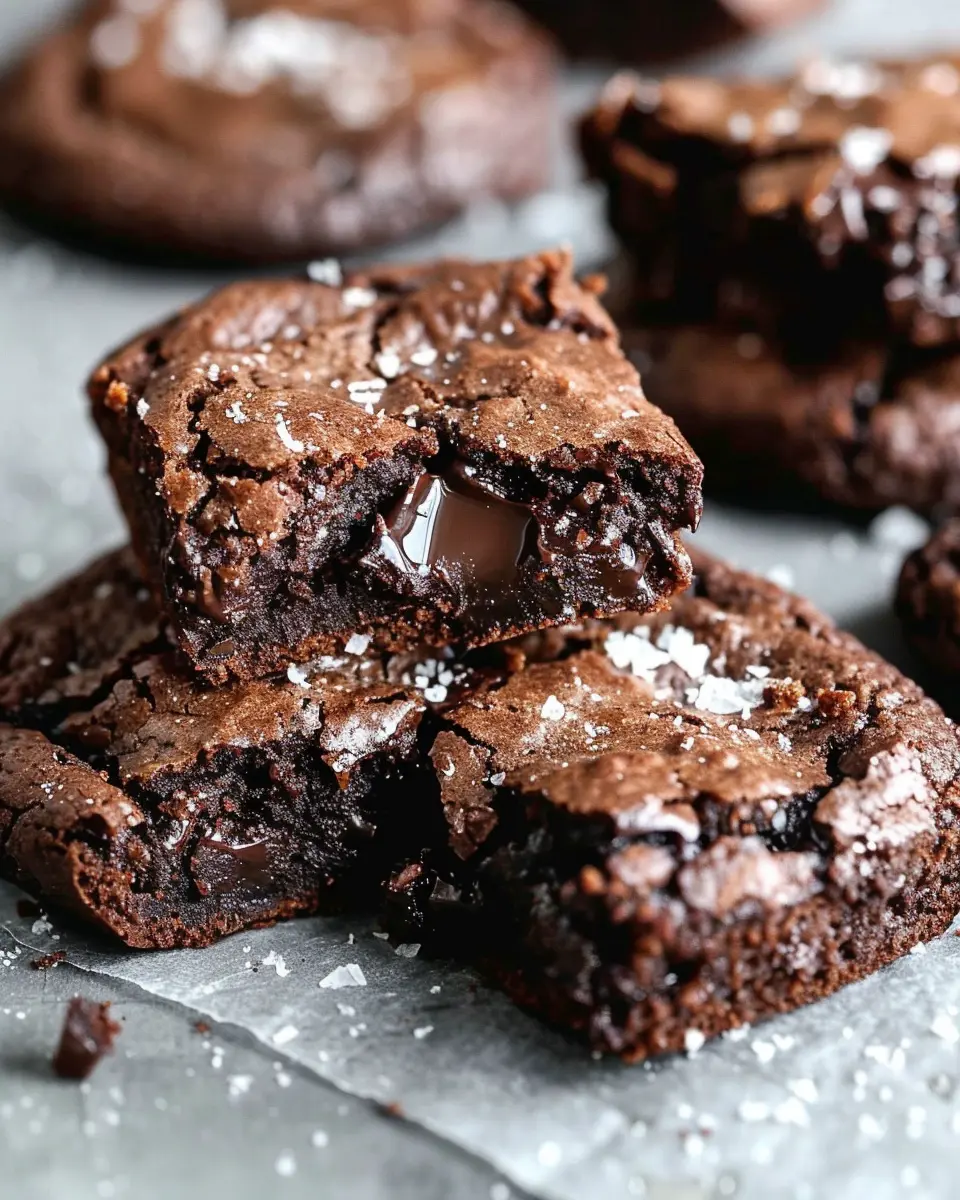Amish White Bread: A Journey Into Deliciousness
Why Amish White Bread is a Game Changer for Home Cooks
If you’re looking for a baking adventure that promises both simplicity and mouthwatering results, then let me introduce you to the delightful world of Amish white bread. Often admired for its fluffy texture and subtly sweet flavor, this bread recipe has been passed down through generations and is sure to impress at your dinner table.
So, what makes this recipe particularly powerful for home cooks? For starters, the ingredient list is refreshingly straightforward. You’ll typically need basic pantry staples like flour, sugar, salt, and yeast, along with water and a splash of oil. The ease of access to these ingredients means you could whip up a fresh batch without much prep time. It’s no wonder this bread finds its way into many kitchens—a nostalgic reminder of simpler times. For a little background on its roots, you can dive into the rich culture of the Amish and their homemade traditions here.
Once you dive into making Amish white bread, you’ll quickly discover the joy of kneading dough by hand, a therapeutic experience that truly engages the senses. Imagine the soft texture beneath your fingers and that satisfying rise as the yeast works its magic. It’s almost like a mini workout—but a lot tastier!
When it comes time to slice into that golden-crusted loaf, the aroma filling your kitchen is reminiscent of a warm hug. It’s perfect for any occasion—whether slathered in butter for breakfast, stacked high with turkey bacon and chicken ham for a hearty sandwich lunch, or even as a base for your favorite toast-topping creations.
Embracing Amish white bread means bringing a slice of wholesome comfort into your home. It encourages creativity too! Consider pairing it with a refreshing side salad, or for a sweet treat, serve it warm with a drizzle of honey. The possibilities are endless, and that’s what makes this bread truly special.
Don’t just take my word for it—try it out yourself and experience the delightful journey into deliciousness! You’ll never look at homemade bread the same way again.

Ingredients for Amish White Bread
Essential ingredients for fluffy bread
Creating that perfect loaf of Amish white bread requires a few key ingredients that work in harmony. Here’s what you’ll need:
- All-purpose flour: This forms the base for your bread. Aim for high-quality flour for the best results.
- Granulated sugar: Just a touch to help the yeast thrive and give your bread a subtle sweetness.
- Active dry yeast: This is the powerhouse that makes your bread rise.
- Warm water: Typically around 110°F (43°C)—warm enough to activate the yeast but not too hot to kill it.
- Salt: Not only for flavor but also to strengthen the dough.
- Butter: A bit of softened unsalted butter adds richness and flavor.
Optional ingredients for flavor enhancements
If you want to take your Amish white bread to the next level, consider these optional ingredients:
- Honey or maple syrup: Swap some sugar for a natural sweetener for added depth.
- Milk: Using milk instead of water can impart a creamier texture.
- Herbs or spices: Adding dried herbs like rosemary or spices like cinnamon can give your bread unique flavors.
By including these additional elements, your Amish white bread can transform from simple to spectacular. Happy baking! For more guidance, check out the baking tips from King Arthur Baking.
Step-by-Step Preparation of Amish White Bread
Making Amish white bread is a delightful journey into the world of baking. The aroma of freshly baked bread is simply irresistible, and following this step-by-step guide will ensure your creation comes out perfectly every time!
Activate the yeast
The first step in making Amish white bread is to activate the yeast, which is essential for creating that delightful rise in your loaf. Start by combining 2 and 1/4 teaspoons of active dry yeast with 1/4 cup of warm water (about 110°F). A pinch of sugar can be added to give the yeast a little extra incentive. Allow this mixture to sit for about 5 to 10 minutes until it becomes frothy. If it doesn’t foam up, it means your yeast is likely dead; don’t worry, just try again with fresh yeast.
Mix dry ingredients
While your yeast is bubbling away, you can prepare the dry ingredients. In a large mixing bowl, combine 4 cups of all-purpose flour, 2 tablespoons of sugar, and 1 teaspoon of salt. Make sure to whisk these together well; this not only mixes the ingredients but also aerates the flour, which contributes to a lighter loaf.
Combine wet and dry ingredients
Next, it’s time to bring everything together! Once the yeast is activated, mix in 1/4 cup of vegetable oil and 1 cup of warm milk (around 110°F) to the yeast mixture. Pour this blend into your dry ingredients. Use a wooden spoon or a spatula to combine until you form a rough dough. The dough will seem somewhat sticky, but don’t worry; that’s how it should feel!
Knead the dough to perfection
Kneading is an incredibly important step in baking bread. Flour your countertop lightly and turn your dough out. Knead it for about 8-10 minutes, stretching and folding it until it becomes smooth and elastic. If the dough sticks to your hands or the surface, sprinkle it with a little more flour. Proper kneading develops the gluten, which contributes to the bread’s texture. The dough should bounce back when you poke it—this is a sign of readiness!
First rise and what to look for
Place your kneaded dough in a greased bowl, covering it with a damp cloth or plastic wrap. Set it in a warm place to rise for 1 to 2 hours, or until it doubles in size. Pro tip: Warm your oven slightly and then turn it off to create a cozy environment for your dough. Keep an eye on it, and you’ll know it’s ready when you can gently poke it and the indention remains.
Shape the dough for the loaf
Once your dough has risen beautifully, punch it down gently to release the air. Now, shape it into a loaf by flattening it into a rectangle, rolling it tightly from one end to the other. Place this shaped loaf in a greased 9×5 inch loaf pan, seam side down.
Second rise: patience is key
Just when you think the hard work is done, there’s one more rise to get through! Cover the loaf with a damp cloth again and let it rise for about 30 to 45 minutes, or until it rises just above the edge of the pan. The key here is patience; this second rise allows for a light and fluffy texture in your Amish white bread.
Bake to golden perfection
Preheat your oven to 350°F as your dough finishes rising. Bake your loaf for about 30 to 35 minutes or until it’s golden-brown on top and sounds hollow when tapped. If you have a thermometer handy, the internal temperature should reach about 190°F. Once done, remove it from the oven and let it cool in the pan for 10 minutes before transferring it to a wire rack.
And there you have it—the perfect Amish white bread! It’s a comforting staple that pairs beautifully with any meal, or simply slathered with butter. Enjoy your warm, homemade bread! For more baking tips, check out King Arthur Baking or The Great British Bake Off.
What are you waiting for? Get that yeast bubbling and share your bread-making journey with friends. They’ll be amazed at your culinary skills!

Variations on Amish White Bread
Amish white bread is a delightful staple, but why stop there? Let’s explore some creative variations that keep the essence of this classic while adding a unique twist!
A Whole Wheat Variation for a Healthier Twist
Looking for a more nutritious option? Try substituting half the all-purpose flour with whole wheat flour in your Amish white bread recipe. This not only enhances the bread’s flavor but also increases its fiber content, making it a heartier choice. Make sure to adjust the liquid slightly since whole wheat flour absorbs more moisture. To dive deeper into this healthy baking option, check out resources at the Whole Grains Council.
Herb-Infused Amish White Bread
For a savory spin, consider folding in your favorite herbs. Chopped rosemary, thyme, or even basil can add an aromatic touch to your Amish white bread. Simply mix about 2 tablespoons of fresh herbs into your dough during the kneading process. This customization pairs beautifully with a bowl of olive oil or a spread of cream cheese, perfect for entertaining guests!
Sweet Amish Bread for Breakfast Treats
Who says bread can’t be sweet? Transform your Amish white bread into a breakfast treat by adding cinnamon and sugar to the dough. You can also incorporate raisins or dried cranberries for an extra pop of flavor. Bake it in a loaf or turn it into delightful cinnamon rolls. This makes for a wonderful morning delight, especially when served warm with a smear of butter.
No matter which variation you choose, these twists on the classic Amish white bread are sure to please your palate and keep your home smelling fantastic! Happy baking!
Cooking Tips and Notes for Amish White Bread
Tips for Perfecting the Texture
Creating luscious Amish white bread with a heavenly texture is an art. Here are some handy tips:
- Use fresh ingredients: Always sift your flour and check the yeast’s expiration date. This step ensures you get that perfect rise.
- Knead your dough adequately: Knead for about 8-10 minutes until it becomes smooth and elastic. This develops gluten, contributing to that classic soft texture.
- Look for the right dough consistency: Your dough should be slightly tacky but not sticky. You can add a bit more flour if it feels too wet.
Common Pitfalls to Avoid
Even the best chefs face challenges! Here’s how to dodge common mistakes:
- Avoid over-proofing: Keep an eye on your dough. If it doubles too much, your bread may collapse.
- Don’t rush the rising process: Patience is key! A warm, draft-free spot will encourage perfect rising.
- Make adjustments based on your environment: Humidity and elevation can affect the dough’s behavior. A bit of trial and error can help you adapt for your kitchen conditions.
Follow these tips, and you’ll be on your way to baking Amish white bread that delights every palate. Need more bread inspiration? Check out King Arthur Baking for stellar techniques.

Serving Suggestions for Amish White Bread
Best ways to enjoy your freshly baked bread
There’s nothing quite like sinking your teeth into a slice of Amish white bread right out of the oven. To get the most out of this delicious loaf, try these serving ideas:
- Simple Toast: A slice, lightly toasted and spread with butter, preserves, or honey makes for a delightful breakfast.
- Sandwich Base: Use it as the foundation for your favorite sandwiches. Think spicy turkey bacon with crisp lettuce, juicy tomatoes, and creamy mayo for a satisfying lunch.
- French Toast: Dip slices into an egg mixture with vanilla and cinnamon, and you’ve got a breakfast classic made better by the rich flavor of your homemade bread.
Creative uses for leftovers
Don’t let any leftover Amish white bread go to waste! Here are a few clever ideas:
- Bread Crumbs: Blitz stale pieces in a food processor to create your own breadcrumbs for topping casseroles or coating chicken ham.
- Bread Pudding: Combine with eggs, milk, and your favorite flavors for a comforting dessert.
- Garlic Bread: Slather slices in garlic butter, toast them, and serve alongside pasta for a perfect accompaniment.
With these tips, your Amish white bread won’t just be a sidekick— it’ll take center stage in your meals! For more inspiration, take a look at sites like The Kitchn and AllRecipes for great ideas around using bread.
Time Breakdown for Amish White Bread
When diving into the comforting world of Amish white bread, understanding the time commitment can help set you up for success. Here’s a quick rundown to keep your baking on track:
Prep Time
Getting started takes about 15 minutes to gather your ingredients and mix them together. It’s the perfect opportunity to unwind and enjoy some music or a podcast as you work.
Rise Time
Patience is key here, with 1 to 2 hours of rise time. This is when your dough transforms, filling your kitchen with a warm, inviting aroma. Use this time to prep any toppings or sides you might want to enjoy with your fresh bread.
Bake Time
The actual baking is fairly quick, taking around 30 to 35 minutes. Keep an eye on your creation as it turns a beautiful golden brown—this is the moment you’ve been waiting for!
Total Time
In total, you’re looking at about 2 to 3 hours, including rise time. This includes a bit of downtime, which is perfect for planning a nice meal around your freshly baked Amish white bread!
For additional tips on achieving the perfect loaf, check out resources from King Arthur Baking or The Bread Kitchen.
Nutritional Facts for Amish White Bread
Key nutritional highlights
When you whip up a batch of Amish white bread, you not only create a comforting staple for your meals but also pack in some notable nutrition. A typical slice contains around 80 calories, 1.5 grams of protein, and minimal fat. It’s a source of healthy carbohydrates, which provide energy for your busy day. Additionally, it can be enriched with various nutrients by incorporating whole grains or seeds into the mix. The use of natural ingredients is a friendlier approach than many processed bread options.
Comparison to store-bought bread
If you’ve ever compared homemade Amish white bread to its store-bought counterparts, you’ve probably noticed some striking differences. Many commercial breads are loaded with preservatives, added sugars, and artificial ingredients that can detract from their nutritional value. In contrast, your homemade version typically avoids these additives, allowing you to enjoy a fresher, more wholesome loaf. Moreover, making your own bread means you have full control over what goes into it. For instance, you can opt for organic flour or choose to include fiber-rich ingredients, making your loaf even healthier!
Interested in a deeper dive into the nutritional benefits of homemade bread? You might find resources from the Grains & Legumes Nutrition Council helpful!
FAQs about Amish White Bread
Making Amish white bread is a delightful experience, but you might have some questions as you embark on this baking journey. Here are some commonly asked questions to help you out!
How can I make my bread rise more effectively?
The secret to a fluffy loaf of Amish white bread often lies in the yeast. Here are a few tips to ensure your bread rises beautifully:
- Use Fresh Yeast: Always check the expiration date on your yeast packet. Fresh yeast works best.
- Warm Water: Activate the yeast in warm (not hot!) water. Aim for a temperature around 110°F (43°C) to create the perfect environment.
- Proof Your Yeast: Let the yeast sit in warm water with sugar for about 5-10 minutes until it’s frothy. If it doesn’t foam up, your yeast may be inactive.
- Kneading: Knead the dough well, as this develops gluten, giving your bread the structure it needs to rise.
Can I freeze Amish white bread?
Absolutely! Freezing is a great way to preserve the freshness of your Amish white bread. Here’s how:
- Cool Completely: Make sure your bread has cooled fully after baking.
- Wrap Well: Use plastic wrap followed by aluminum foil or a freezer-safe bag to prevent freezer burn.
- Label and Date: Don’t forget to mark the date, so you know when to enjoy it!
When you’re ready to savor it, simply thaw at room temperature or toast slices directly from the freezer.
What are some common substitutes for bread ingredients?
If you find yourself missing an ingredient while making Amish white bread, don’t worry! Here are some substitutions you can try:
- All-Purpose Flour: If you don’t have bread flour, all-purpose flour works fine, although your bread may be slightly less chewy.
- Honey or Sugar: You can replace granulated sugar with honey—just use a bit less and add a little extra flour.
- Milk Alternatives: If you’re out of milk, almond milk or even water can work in a pinch.
For more tips on baking substitutions, check out The Kitchn. Enjoy your baking adventure!
Conclusion on Amish White Bread
Recap of the Joys of Homemade Bread
There’s something truly therapeutic about kneading dough and watching your very own loaf transform right before your eyes. Making Amish white bread is not just about the final product—it’s about the entire experience. The warm, comforting aroma that fills your kitchen, the satisfaction of creating something from scratch, and ultimately, the joy of sharing a slice with loved ones.
I encourage you to try this recipe and savor the delightful taste of freshly baked bread. Whether it’s for sandwiches or simply to enjoy with a spread, homemade bread elevates every meal. For more tips on homemade delights, check out resources like King Arthur Baking or BBC Good Food for a broader baking journey!
Print
Amish White Bread: Easy Homemade Loaf for Delicious Dishes
This Amish White Bread recipe is simple and yields a deliciously soft and fluffy loaf, perfect for sandwiches or toast.
- Total Time: 2 hours
- Yield: 1 loaf 1x
Ingredients
- 4 cups all-purpose flour
- 2 tablespoons sugar
- 1 tablespoon salt
- 2 cups warm water
- 1 packet active dry yeast
Instructions
- In a bowl, dissolve the yeast in warm water.
- Add sugar, salt, and flour; mix until a dough forms.
- Knead the dough on a floured surface for 8-10 minutes.
- Place in a greased bowl, cover, and let rise until doubled in size.
- Punch down the dough, shape it, and place in a greased loaf pan.
- Let it rise again until it reaches the top of the pan.
- Bake at 350°F for 30-35 minutes.
- Cool before slicing.
Notes
- For a richer flavor, consider adding a tablespoon of butter to the dough.
- Ensure the water is not too hot, or it may kill the yeast.
- Prep Time: 15 minutes
- Cook Time: 35 minutes
- Category: Bread
- Method: Baking
- Cuisine: American
- Diet: Vegetarian
Nutrition
- Serving Size: 1 slice
- Calories: 120
- Sugar: 1g
- Sodium: 150mg
- Fat: 1g
- Saturated Fat: 0g
- Unsaturated Fat: 0g
- Trans Fat: 0g
- Carbohydrates: 24g
- Fiber: 1g
- Protein: 3g
- Cholesterol: 0mg
Keywords: AMISH WHITE BREAD











